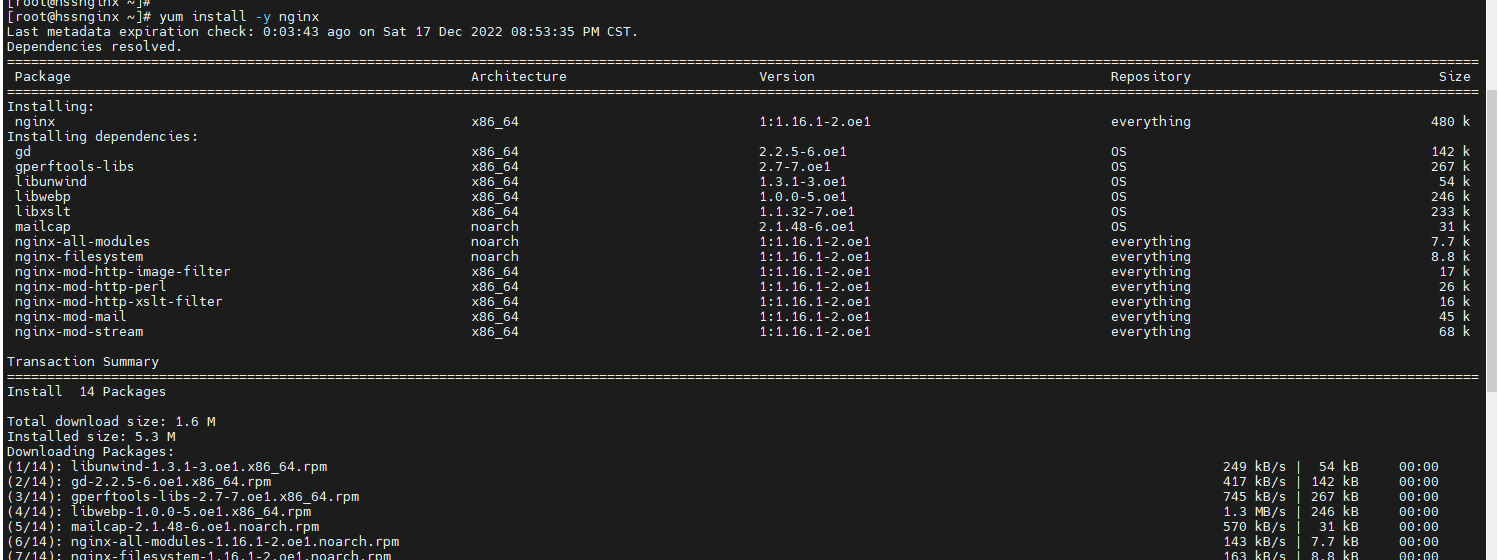Installing and Configuring Nginx on the Proxy Server
Nginx forwards requests from a third-party server to the HSS management console.
Installing and Configuring Nginx on the Proxy Server
- Log in to the proxy server.
- Check the Yum repository.
Check whether the Nginx software package exists in the Yum repository. If the Nginx software package does not exist, configure the Yum repository and bind the public IP address temporarily. After the installation is complete, unbind the public IP address.
Remotely log in to the proxy server and run the following command to check whether the Nginx package exists in the Yum repository:
- For EulerOS, CentOS and Red Hat, or other OSs that support RPM installation, run the yum list nginx command.
- For OSs that support DEB installation, such as Ubuntu and Debian, run the apt list nginx command.
If the information shown in The Nginx package exists (rpm) or The Nginx package exists (deb) is displayed, the Nginx package exists. - Installing Nginx
- Run the following command to install Nginx using Yum:
- For EulerOS, CentOS and Red Hat, or other OSs that support RPM installation, run the yum install -y nginx command.
- For OSs that support DEB installation, such as Ubuntu and Debian, run the apt install -y nginx command.
Figure 3 Installing Nginx (yum) Figure 4 Installing Nginx (apt)
Figure 4 Installing Nginx (apt)
- Check whether the Nginx installation is successful.
- For OSs that support RPM installation, such as EulerOS, CentOS, and Red Hat:
The installation is automatically performed. If Complete! shown in Nginx installed successfully (rpm) is displayed, the installation is successful.
- For OSs that support DEB installation, such as Ubuntu and Debian:
Run the pkg –l nginx command. If the command output shown in Nginx installed successfully (deb) is displayed, the installation is successful.
- For OSs that support RPM installation, such as EulerOS, CentOS, and Red Hat:
- Run the following command to install Nginx using Yum:
- Configuring Nginx
- Run the following command to go to the Nginx directory:
- Run the following command to sign the certificate:
openssl req -new -x509 -nodes -out server.pem -keyout server.key -days 36500
After the command is executed, enter the certificate information. The value of Country Name can contain only two characters.
Figure 7 Self-signed certificate
- Run the following command to modify nginx.conf:
- Run the following commands one by one to modify nginx.conf:
rm -f nginx.conf
vi nginx.conf
- Press i to enter the editing mode and copy the following content to the nginx.conf file:
1 2 3 4 5 6 7 8 9 10 11 12 13 14 15 16 17 18 19 20 21 22 23 24 25 26 27 28 29 30 31 32 33 34 35 36 37 38 39 40 41 42 43 44 45 46 47 48 49 50 51 52 53 54 55 56 57 58 59 60 61 62 63 64 65 66 67 68 69 70 71 72 73 74 75
user nginx; worker_processes auto; error_log /var/log/nginx/error.log; pid /run/nginx.pid; include /usr/share/nginx/modules/*.conf; events { worker_connections 1024; } http { log_format main '$remote_addr - $remote_user [$time_local] "$request" ' '$status $body_bytes_sent "$http_referer" ' '"$http_user_agent" "$http_x_forwarded_for"'; access_log /var/log/nginx/access.log main; sendfile on; tcp_nopush on; tcp_nodelay on; keepalive_timeout 65; types_hash_max_size 2048; include /etc/nginx/mime.types; default_type application/octet-stream; # Load modular configuration files from the /etc/nginx/conf.d directory. # for more information. include /etc/nginx/conf.d/*.conf; upstream backend_hss { server ADDR:10180; } server { listen 10180; server_name ADDR; root /usr/share/nginx/html; # Load configuration files for the default server block. include /etc/nginx/default.d/*.conf; ssl on; ssl_protocols TLSv1.2; ssl_certificate "server.pem"; ssl_certificate_key "server.key"; ssl_session_cache shared:SSL:10m; ssl_session_timeout 10m; ssl_prefer_server_ciphers on; location / { limit_except GET POST PUT { deny all; } proxy_set_header Host ADDR; proxy_pass https://backend_hss; proxy_set_header Upgrade $http_upgrade; proxy_set_header Connection "upgrade"; } error_page 404 /404.html; location = /40x.html { } error_page 500 502 503 504 /50x.html; location = /50x.html { } } }
- Optional: Paste the content, press Esc, run the following command, and press Enter to exit.
:wq!
- Run the following command to automatically replace the IP address in the nginx.conf file:
sed -i "s#ADDR#`cat /usr/local/hostguard/conf/connect.conf | grep master_address | cut -d '=' -f 2 | cut -d ':' -f 1`#g" nginx.conf
- Run the following commands one by one to modify nginx.conf:
- Perform the following operations to create the Nginx monitoring script: After the creation is complete, the Nginx running status is checked every minute.
- Run the following commands one by one to create the Nginx monitoring script:
echo '*/1 * * * * root sh /etc/nginx/nginx_monitor.sh' >> /etc/crontab
vi /etc/nginx/nginx_monitor.sh
Figure 8 Creating an Nginx monitoring script
- Copy the following content to nginx_monitor.sh:
#!/bin/bash counter=$(ps -C nginx --no-heading|wc -l) if [ "${counter}" = "0" ]; then systemctl start nginx.service fiFigure 9 Configuring nginx_monitor.sh
- Paste the content, press Esc, run the following command, and press Enter to exit.
:wq!
- Run the following commands one by one to create the Nginx monitoring script:
- Wait 1 minute and run the following command to check whether the Nginx process has been started successfully:
If the command output shown in Nginx process started successfully is displayed, the Nginx process is started. Perform the Creating an Agent Installation Package or Installation Commands Using a Proxy Server.
Feedback
Was this page helpful?
Provide feedbackThank you very much for your feedback. We will continue working to improve the documentation.See the reply and handling status in My Cloud VOC.
For any further questions, feel free to contact us through the chatbot.
Chatbot










